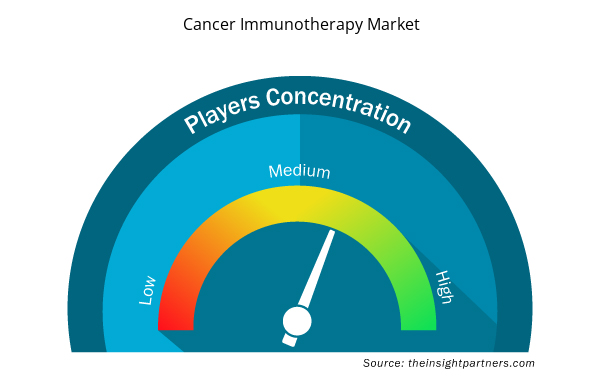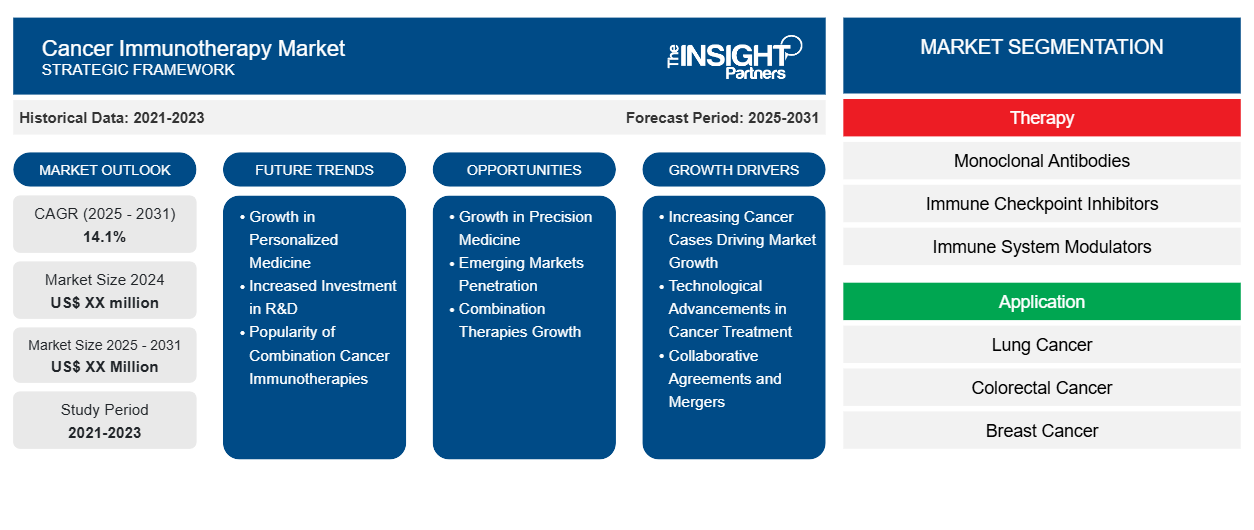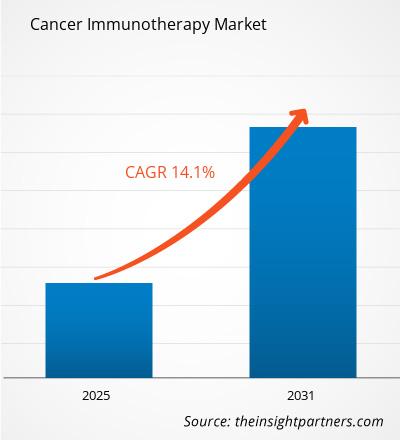Si prevede che il mercato dell'immunoterapia contro il cancro registrerà un CAGR del 14,1% dal 2023 al 2031, con una dimensione di mercato in espansione da XX milioni di dollari nel 2023 a XX milioni di dollari entro il 2031.
Il rapporto di mercato dell'immunoterapia contro il cancro comprende l'analisi per terapia (anticorpi monoclonali, inibitori dei checkpoint immunitari, modulatori del sistema immunitario, vaccini contro il cancro); applicazione (cancro ai polmoni, cancro del colon-retto, cancro al seno, cancro alla prostata, melanoma, cancro alla testa e al collo, cancro alle ovaie, altri); utente finale (ospedali, centri chirurgici ambulatoriali, centri di ricerca sul cancro, cliniche specialistiche). L'analisi globale è ulteriormente suddivisa a livello regionale e nei principali paesi. Il rapporto offre il valore in USD per l'analisi e i segmenti di cui sopra.
Scopo del rapporto
Il report Cancer Immunotherapy Market di The Insight Partners mira a descrivere il panorama attuale e la crescita futura, i principali fattori trainanti, le sfide e le opportunità. Ciò fornirà spunti a vari stakeholder aziendali, come:
- Fornitori/produttori di tecnologia: per comprendere le dinamiche di mercato in evoluzione e conoscere le potenziali opportunità di crescita, consentendo loro di prendere decisioni strategiche informate.
- Investitori: condurre un'analisi completa delle tendenze in merito al tasso di crescita del mercato, alle proiezioni finanziarie del mercato e alle opportunità esistenti lungo la catena del valore.
- Enti di regolamentazione: regolamentano le politiche e le attività di controllo sul mercato allo scopo di ridurre al minimo gli abusi, preservare la fiducia degli investitori e sostenere l'integrità e la stabilità del mercato.
Segmentazione del mercato dell'immunoterapia contro il cancro
Terapia
- Anticorpi monoclonali
- Inibitori del checkpoint immunitario
- Modulatori del sistema immunitario
- Vaccini contro il cancro
Applicazione
- Cancro al polmone
- Cancro colorettale
- Tumore al seno
- Cancro alla prostata
- Melanoma
- Cancro alla testa e al collo
- Cancro ovarico
Utente finale
- Ospedali
- Centri di chirurgia ambulatoriale
- Centri di ricerca sul cancro
- Cliniche specialistiche
Geografia
- America del Nord
- Europa
- Asia-Pacifico
- America del Sud e Centro
- Medio Oriente e Africa
Geografia
- America del Nord
- Europa
- Asia-Pacifico
- America del Sud e Centro
- Medio Oriente e Africa
Personalizza questo report in base alle tue esigenze
Riceverai la personalizzazione gratuita di qualsiasi report, comprese parti di questo report, o analisi a livello nazionale, pacchetto dati Excel, oltre a usufruire di grandi offerte e sconti per start-up e università
- Scopri le principali tendenze di mercato in questo rapporto.Questo campione GRATUITO includerà analisi di dati che spaziano dalle tendenze di mercato alle stime e alle previsioni.
Fattori trainanti della crescita del mercato dell'immunoterapia contro il cancro
- L'aumento dei casi di cancro guida la crescita del mercato: la crescente incidenza globale del cancro sta guidando la domanda di nuovi agenti terapeutici, con farmaci innovativi che prendono di mira le cellule tumorali e supportano tassi di mortalità ridotti tramite l'immunoterapia. Gli investimenti nell'assistenza sanitaria, le iniziative governative e le campagne di sensibilizzazione globali stanno espandendo il mercato.
- Progressi tecnologici nel trattamento del cancro: la terapia con cellule CAR-T è una svolta nel trattamento del cancro, migliorando i risultati. La continua R&S, le sperimentazioni cliniche e i nuovi lanci di farmaci stanno contribuendo alla crescita del mercato modificando i protocolli di trattamento.
- Accordi di collaborazione e fusioni: le partnership tra aziende farmaceutiche, istituti di ricerca e università stanno migliorando la diversificazione dei prodotti e la penetrazione del mercato. Queste collaborazioni modellano l'analisi competitiva e le tendenze di mercato, portando a tassi di adozione più elevati.
Tendenze future del mercato dell'immunoterapia contro il cancro
- Crescita nella medicina personalizzata: il mercato della medicina personalizzata sta crescendo con trattamenti individualizzati in oncologia, in particolare immunoterapie personalizzate per il cancro, adattate ai profili genetici. Le aziende si stanno concentrando su innovazione e partnership per capitalizzare la crescente domanda di medicina di precisione.
- Maggiori investimenti in R&S: l'attenzione sulle immunoterapie di nuova generazione, in particolare le terapie con cellule CAR T, sta guidando la crescita del mercato. Le partnership tra giganti farmaceutici e startup biotech sono fondamentali per far progredire la concorrenza di mercato.
- Popolarità delle immunoterapie combinate contro il cancro: il crescente utilizzo di terapie combinate, che combinano immunoterapie con chemioterapia o farmaci mirati, aumenta l'efficacia del trattamento. Fusioni strategiche, collaborazioni e partnership sono essenziali per i player per massimizzare la sinergia e guidare la crescita.
Opportunità di mercato dell'immunoterapia contro il cancro
- Crescita nella medicina di precisione: la terapia di precisione contro il cancro sta guidando la crescita dell'immunoterapia di precisione contro il cancro, offrendo trattamenti specifici per tumore. Elevata domanda in Nord America per terapie come gli inibitori dei checkpoint e le terapie cellulari adottive. Il segmento favorisce l'innovazione, fornendo una solida posizione di mercato per le aziende.
- Penetrazione nei mercati emergenti: forti investimenti in sanità nei mercati emergenti offrono opportunità per approfondire la penetrazione dell'immunoterapia. L'elevata incidenza del cancro in queste regioni offre un notevole margine di espansione del mercato, consentendo alle aziende di aumentare la quota di mercato e di ampliare l'accesso alle cure oncologiche.
- Crescita delle terapie combinate: la combinazione di immunoterapia e chemioterapia è un'opportunità di crescita elevata volta a migliorare l'efficacia del trattamento e i tassi di sopravvivenza. Questa tendenza rafforza le posizioni di mercato delle aziende, in particolare nella prossima fase di ricerca e sviluppo del trattamento.
Approfondimenti regionali sul mercato dell'immunoterapia contro il cancro
Le tendenze regionali e i fattori che influenzano il mercato dell'immunoterapia contro il cancro durante il periodo di previsione sono stati ampiamente spiegati dagli analisti di Insight Partners. Questa sezione discute anche i segmenti e la geografia del mercato dell'immunoterapia contro il cancro in Nord America, Europa, Asia Pacifico, Medio Oriente e Africa e America meridionale e centrale.

- Ottieni i dati specifici regionali per il mercato dell'immunoterapia del cancro
Ambito del rapporto di mercato sull'immunoterapia del cancro
| Attributo del report | Dettagli |
|---|---|
| Dimensioni del mercato nel 2023 | XX milioni di dollari USA |
| Dimensioni del mercato entro il 2031 | XX milioni di dollari USA |
| CAGR globale (2023-2031) | 14,1% |
| Dati storici | 2021-2022 |
| Periodo di previsione | 2024-2031 |
| Segmenti coperti | Per terapia
|
| Regioni e Paesi coperti | America del Nord
|
| Leader di mercato e profili aziendali chiave |
|
Densità degli attori del mercato dell'immunoterapia contro il cancro: comprendere il suo impatto sulle dinamiche aziendali
Il mercato dell'immunoterapia contro il cancro sta crescendo rapidamente, spinto dalla crescente domanda degli utenti finali dovuta a fattori quali l'evoluzione delle preferenze dei consumatori, i progressi tecnologici e una maggiore consapevolezza dei benefici del prodotto. Con l'aumento della domanda, le aziende stanno ampliando le loro offerte, innovando per soddisfare le esigenze dei consumatori e capitalizzando sulle tendenze emergenti, il che alimenta ulteriormente la crescita del mercato.
La densità degli operatori di mercato si riferisce alla distribuzione di aziende o società che operano in un particolare mercato o settore. Indica quanti concorrenti (operatori di mercato) sono presenti in un dato spazio di mercato in relazione alle sue dimensioni o al valore di mercato totale.
Le principali aziende che operano nel mercato dell'immunoterapia del cancro sono:
- F. Hoffmann-La Roche AG
- Società anonima Advaxis Inc.
- Merck & Co., Inc.
- Eli Lilly e la società
- Società Bristol-Myers Squibb
Disclaimer : le aziende elencate sopra non sono classificate secondo un ordine particolare.

- Ottieni una panoramica dei principali attori del mercato dell'immunoterapia contro il cancro
Punti chiave di vendita
- Copertura completa: il rapporto copre in modo completo l'analisi di prodotti, servizi, tipologie e utenti finali del mercato dell'immunoterapia contro il cancro, fornendo una panoramica olistica.
- Analisi degli esperti: il rapporto è compilato sulla base della conoscenza approfondita di esperti e analisti del settore.
- Informazioni aggiornate: il rapporto garantisce la pertinenza aziendale grazie alla copertura di informazioni recenti e tendenze nei dati.
- Opzioni di personalizzazione: questo report può essere personalizzato per soddisfare le esigenze specifiche del cliente e adattarsi in modo appropriato alle strategie aziendali.
Il rapporto di ricerca sul mercato dell'immunoterapia contro il cancro può quindi aiutare a guidare il percorso di decodifica e comprensione dello scenario del settore e delle prospettive di crescita. Sebbene possano esserci alcune preoccupazioni valide, i vantaggi complessivi di questo rapporto tendono a superare gli svantaggi.
- Analisi storica (2 anni), anno base, previsione (7 anni) con CAGR
- Analisi PEST e SWOT
- Valore/volume delle dimensioni del mercato - Globale, regionale, nazionale
- Industria e panorama competitivo
- Set di dati Excel


- Underwater Connector Market
- Fertilizer Additives Market
- MEMS Foundry Market
- Electronic Shelf Label Market
- Bioremediation Technology and Services Market
- Single Pair Ethernet Market
- Aquaculture Market
- Airport Runway FOD Detection Systems Market
- Real-Time Location Systems Market
- Artificial Intelligence in Healthcare Diagnosis Market

Report Coverage
Revenue forecast, Company Analysis, Industry landscape, Growth factors, and Trends

Segment Covered
This text is related
to segments covered.

Regional Scope
North America, Europe, Asia Pacific, Middle East & Africa, South & Central America

Country Scope
This text is related
to country scope.
Domande frequenti
Some of the customization options available based on request are additional 3-5 company profiles and country-specific analysis of 3-5 countries of your choice. Customizations are to be requested/discussed before making final order confirmation, as our team would review the same and check the feasibility.
The report can be delivered in PDF/PPT format; we can also share excel dataset based on the request.
Key companies of this market are: F. Hoffmann-La Roche AG, Advaxis Inc., Merck & Co., Inc., Eli Lilly and Company, Bristol-Myers Squibb Company, Pfizer Inc., Novartis AG, Bayer AG, Immunomedics Inc.
Key future trends in this market are - Increasing Adoption of Personalized Medicine, Rising Investments in R&D, Expansion of Combination Therapies
The Cancer Immunotherapy Market is estimated to witness a CAGR of 14.1% from 2023 to 2031.
The major factors driving the Market are: Growing cancer prevalence, Technological advancements in treatments, Collaborative agreements and mergers
Trends and growth analysis reports related to Life Sciences : READ MORE..
1. F. Hoffmann-La Roche AG2. Advaxis Inc.3. Merck & Co., Inc.4. Eli Lilly and Company5. Bristol-Myers Squibb Company6. Pfizer Inc.7. Novartis AG8. Bayer AG9. Immunomedics Inc.10. Astrazeneca plc.
The Insight Partners performs research in 4 major stages: Data Collection & Secondary Research, Primary Research, Data Analysis and Data Triangulation & Final Review.
- Data Collection and Secondary Research:
As a market research and consulting firm operating from a decade, we have published and advised several client across the globe. First step for any study will start with an assessment of currently available data and insights from existing reports. Further, historical and current market information is collected from Investor Presentations, Annual Reports, SEC Filings, etc., and other information related to company’s performance and market positioning are gathered from Paid Databases (Factiva, Hoovers, and Reuters) and various other publications available in public domain.
Several associations trade associates, technical forums, institutes, societies and organization are accessed to gain technical as well as market related insights through their publications such as research papers, blogs and press releases related to the studies are referred to get cues about the market. Further, white papers, journals, magazines, and other news articles published in last 3 years are scrutinized and analyzed to understand the current market trends.
- Primary Research:
The primarily interview analysis comprise of data obtained from industry participants interview and answers to survey questions gathered by in-house primary team.
For primary research, interviews are conducted with industry experts/CEOs/Marketing Managers/VPs/Subject Matter Experts from both demand and supply side to get a 360-degree view of the market. The primary team conducts several interviews based on the complexity of the markets to understand the various market trends and dynamics which makes research more credible and precise.
A typical research interview fulfils the following functions:
- Provides first-hand information on the market size, market trends, growth trends, competitive landscape, and outlook
- Validates and strengthens in-house secondary research findings
- Develops the analysis team’s expertise and market understanding
Primary research involves email interactions and telephone interviews for each market, category, segment, and sub-segment across geographies. The participants who typically take part in such a process include, but are not limited to:
- Industry participants: VPs, business development managers, market intelligence managers and national sales managers
- Outside experts: Valuation experts, research analysts and key opinion leaders specializing in the electronics and semiconductor industry.
Below is the breakup of our primary respondents by company, designation, and region:

Once we receive the confirmation from primary research sources or primary respondents, we finalize the base year market estimation and forecast the data as per the macroeconomic and microeconomic factors assessed during data collection.
- Data Analysis:
Once data is validated through both secondary as well as primary respondents, we finalize the market estimations by hypothesis formulation and factor analysis at regional and country level.
- Macro-Economic Factor Analysis:
We analyse macroeconomic indicators such the gross domestic product (GDP), increase in the demand for goods and services across industries, technological advancement, regional economic growth, governmental policies, the influence of COVID-19, PEST analysis, and other aspects. This analysis aids in setting benchmarks for various nations/regions and approximating market splits. Additionally, the general trend of the aforementioned components aid in determining the market's development possibilities.
- Country Level Data:
Various factors that are especially aligned to the country are taken into account to determine the market size for a certain area and country, including the presence of vendors, such as headquarters and offices, the country's GDP, demand patterns, and industry growth. To comprehend the market dynamics for the nation, a number of growth variables, inhibitors, application areas, and current market trends are researched. The aforementioned elements aid in determining the country's overall market's growth potential.
- Company Profile:
The “Table of Contents” is formulated by listing and analyzing more than 25 - 30 companies operating in the market ecosystem across geographies. However, we profile only 10 companies as a standard practice in our syndicate reports. These 10 companies comprise leading, emerging, and regional players. Nonetheless, our analysis is not restricted to the 10 listed companies, we also analyze other companies present in the market to develop a holistic view and understand the prevailing trends. The “Company Profiles” section in the report covers key facts, business description, products & services, financial information, SWOT analysis, and key developments. The financial information presented is extracted from the annual reports and official documents of the publicly listed companies. Upon collecting the information for the sections of respective companies, we verify them via various primary sources and then compile the data in respective company profiles. The company level information helps us in deriving the base number as well as in forecasting the market size.
- Developing Base Number:
Aggregation of sales statistics (2020-2022) and macro-economic factor, and other secondary and primary research insights are utilized to arrive at base number and related market shares for 2022. The data gaps are identified in this step and relevant market data is analyzed, collected from paid primary interviews or databases. On finalizing the base year market size, forecasts are developed on the basis of macro-economic, industry and market growth factors and company level analysis.
- Data Triangulation and Final Review:
The market findings and base year market size calculations are validated from supply as well as demand side. Demand side validations are based on macro-economic factor analysis and benchmarks for respective regions and countries. In case of supply side validations, revenues of major companies are estimated (in case not available) based on industry benchmark, approximate number of employees, product portfolio, and primary interviews revenues are gathered. Further revenue from target product/service segment is assessed to avoid overshooting of market statistics. In case of heavy deviations between supply and demand side values, all thes steps are repeated to achieve synchronization.
We follow an iterative model, wherein we share our research findings with Subject Matter Experts (SME’s) and Key Opinion Leaders (KOLs) until consensus view of the market is not formulated – this model negates any drastic deviation in the opinions of experts. Only validated and universally acceptable research findings are quoted in our reports.
We have important check points that we use to validate our research findings – which we call – data triangulation, where we validate the information, we generate from secondary sources with primary interviews and then we re-validate with our internal data bases and Subject matter experts. This comprehensive model enables us to deliver high quality, reliable data in shortest possible time.


 Ottieni un campione gratuito per questo repot
Ottieni un campione gratuito per questo repot